There are indeed 11 owl species that grace the landscapes of Maine, each contributing its unique presence to the state’s rich biodiversity.
From the haunting calls of the Boreal Owl in dense forests to the adaptable Great Horned Owl patrolling suburban areas, Maine hosts a diverse owl community.
This introduction invites you to embark on a journey through the enchanting world of Owls in Maine, exploring their habitats, behaviors, and the vital roles they play in the delicate balance of nature.
Join us as we unravel the mysteries of these nocturnal hunters, shedding light on their captivating lifestyles against the backdrop of Maine’s varied ecosystems.
Get ready for an owl-centered adventure that unveils the beauty and significance of these remarkable birds in the heart of Maine’s wilderness. Stay focused.
11 Owls in Maine
Each owl species has specific habitat preferences, ranging from dense boreal forests for the Boreal Owl to open grasslands for the Burrowing Owl.
Their ecological roles as nocturnal predators contribute to controlling populations of rodents and insects, helping maintain the balance of local ecosystems.
Owls play a crucial role in the food web, preying on various small mammals, birds, and insects.
Adapting to different environments, their hunting strategies reflect their specialization in particular niches within Maine’s diverse landscapes.
Explore the enchanting world of owls in Maine, where diverse habitats provide a home to a variety of these fascinating birds.
From the elusive Boreal Owl to the charming Eastern Screech Owl, each species brings its unique charm and lifestyle to the Maine wilderness.
1. Long-eared Owl
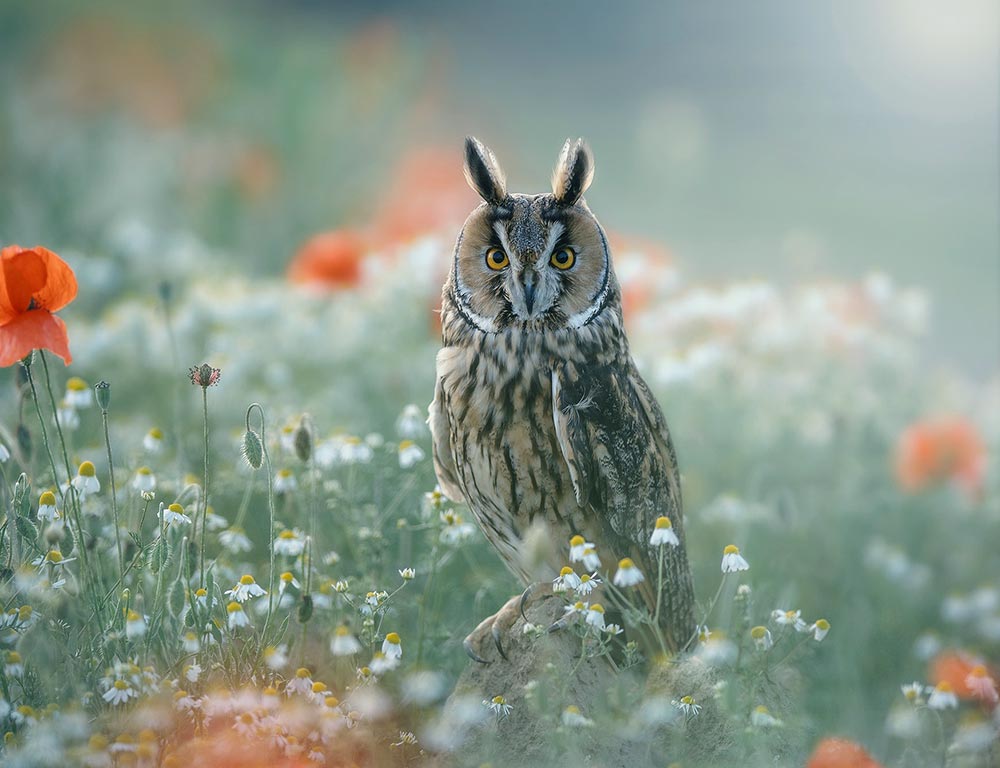
- Scientific name: Asio otus
- Life span: Up to 10 years
- Size: 13-16 inches
- Weight: 7-16 ounces
- Food: Mainly small mammals, birds, and insects
- Wingspan: 35-42 inches
- Status: Generally stable
The Long-eared Owl in Maine is a medium-sized owl with distinctive long “ear” tufts. They inhabit dense woodlands and coniferous forests.
Their lifestyle is predominantly nocturnal, with a preference for hunting at dusk and dawn.
Long-eared Owls primarily feed on small mammals, such as mice and voles, as well as birds and insects. They are known for their silent flight, aided by specialized feathers that muffle sound.
2. Barred Owl
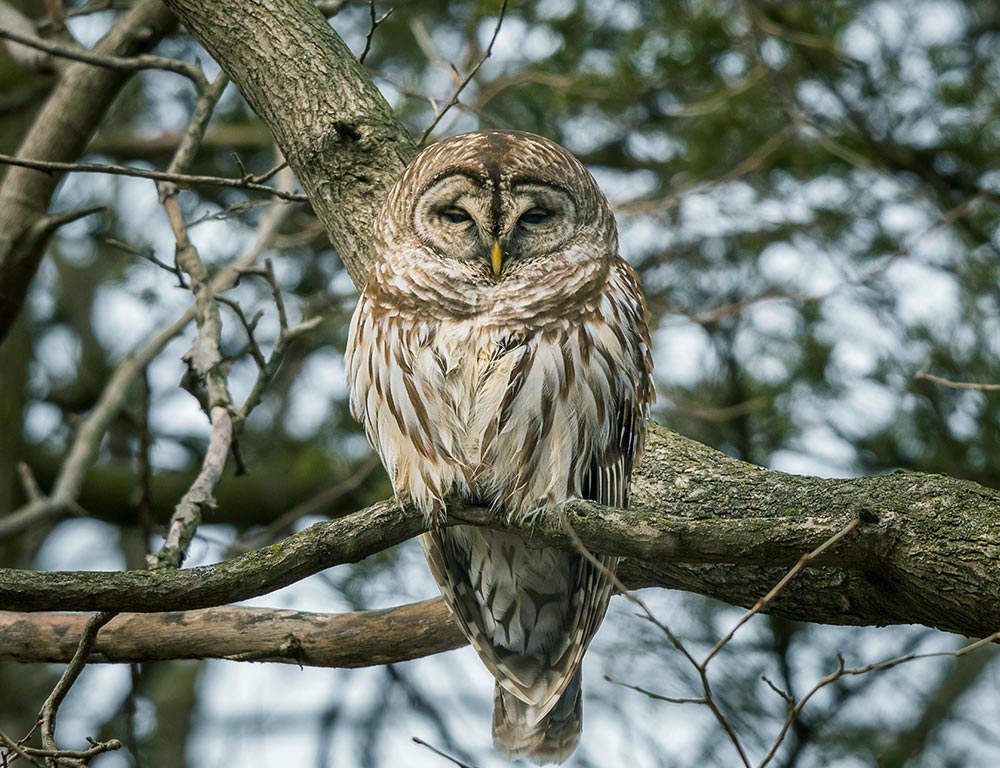
- Scientific name: Strix varia
- Life span: Up to 10 years
- Size: 16-25 inches
- Weight: 1-2.5 pounds
- Food: Rodents, birds, amphibians, and invertebrates
- Wingspan: 38-50 inches
- Status: Common
The Barred Owl, common in Maine, is a medium to large-sized owl with a distinctive hooting call. They inhabit a variety of wooded habitats and are adaptable to suburban areas.
Barred Owls are primarily nocturnal, and their diet includes rodents, birds, amphibians, and invertebrates. They are skilled hunters with keen senses, aided by their excellent hearing and vision.
3. Snowy Owl

- Scientific name: Bubo scandiacus
- Life span: Up to 9.5 years
- Size: 20-28 inches
- Weight: 3-6.6 pounds
- Food: Lemmings, rodents, birds
- Wingspan: 49-59 inches
- Status: Varies (irruptive species)
The Snowy Owl, known for its striking white plumage, is a rare visitor to Maine.
They are irruptive migrants, meaning their presence depends on prey availability. Snowy Owls primarily hunt lemmings, rodents, and birds in their Arctic breeding grounds.
Their lifestyle in Maine is influenced by food availability, and they may be spotted in open areas like fields and coastal areas.
4. Great Horned Owl
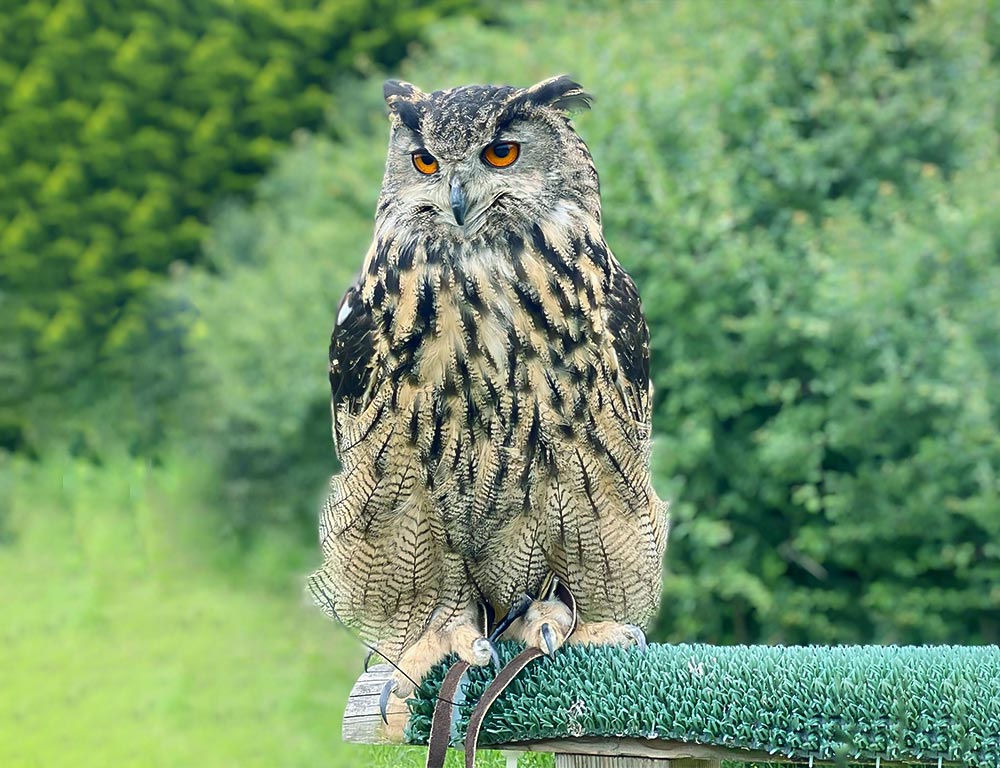
- Scientific name: Bubo virginianus
- Life span: Up to 20 years
- Size: 18-25 inches
- Weight: 2-5.5 pounds
- Food: Mammals, birds, reptiles, and amphibians
- Wingspan: 39-57 inches
- Status: Common
The Great Horned Owl is large and powerful, common in Maine’s diverse habitats. They are adaptable and can be found in forests, deserts, and urban areas.
Great Horned Owls are apex predators, preying on various animals, including mammals, birds, reptiles, and amphibians.
Their lifestyle involves a mix of nocturnal hunting and daytime roosting in well-concealed locations.
5. Northern Saw-whet Owl
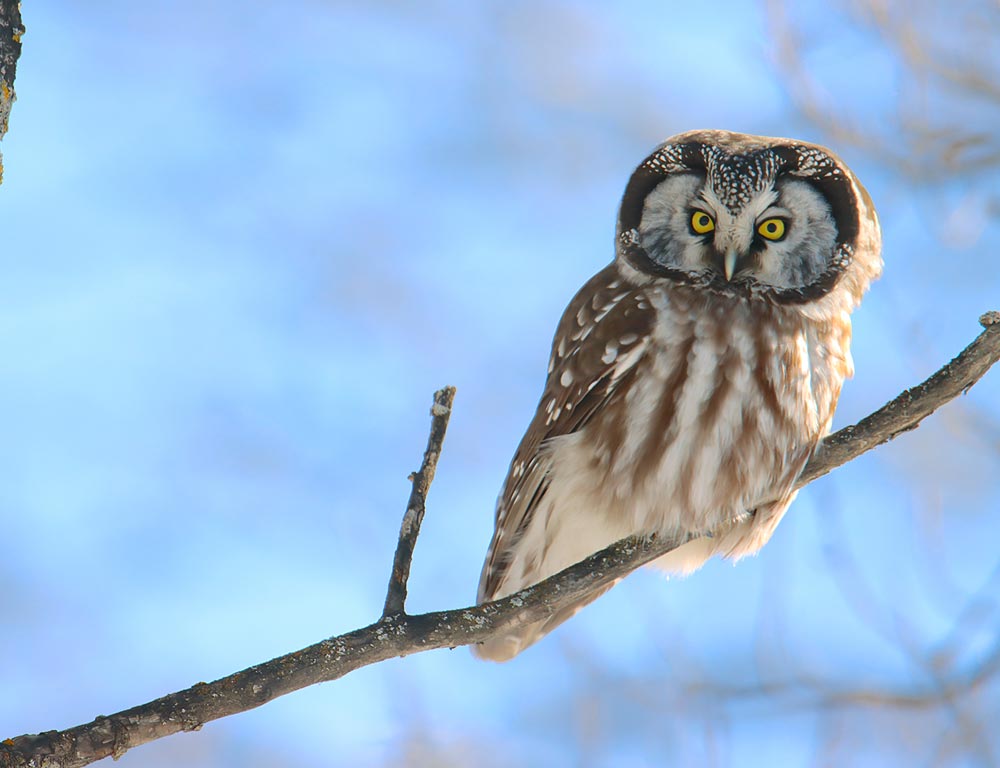
- Scientific name: Aegolius acadicus
- Life span: Up to 7 years
- Size: 7-8 inches
- Weight: 2-5 ounces
- Food: Small mammals, birds, insects
- Wingspan: 16-18 inches
- Status: Common
The Northern Saw-whet Owl is a small owl species found in Maine’s forests. Despite their small size, they are efficient predators, feeding on small mammals, birds, and insects.
Their lifestyle is nocturnal, with a distinctive call resembling the sound of a saw being sharpened.
Saw-whet Owls often use coniferous trees for roosting during the day, and their cryptic plumage provides excellent camouflage.
6. Great Grey Owl
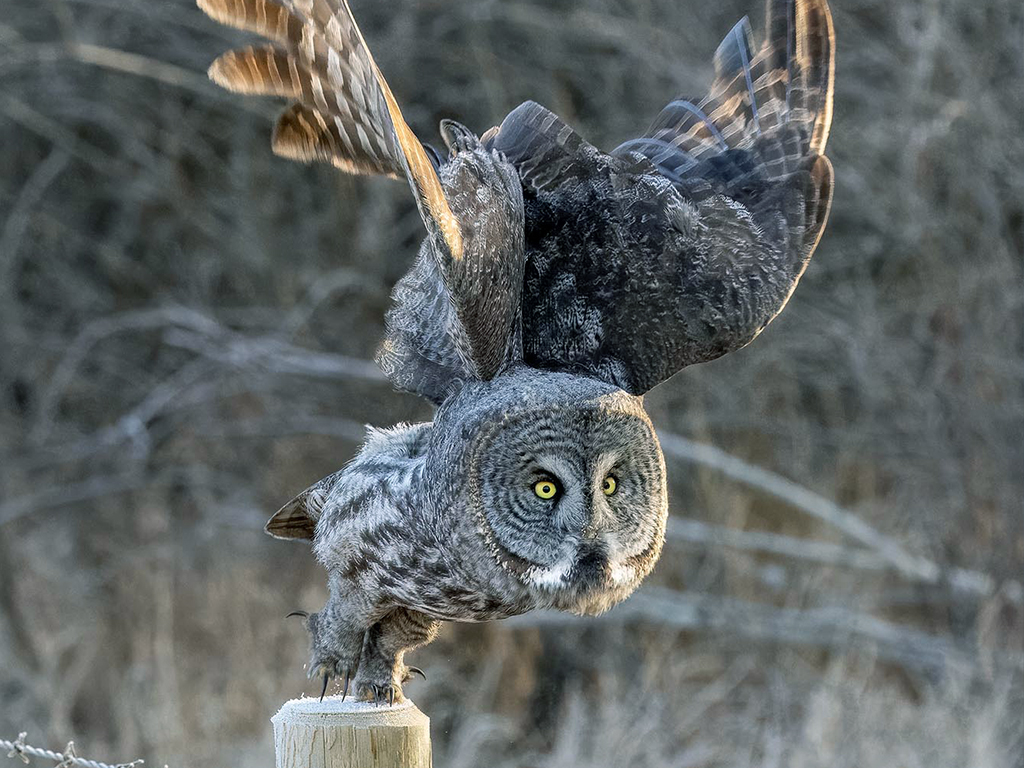
- Scientific name: Strix nebulosa
- Life span: Up to 10 years
- Size: 24-33 inches
- Weight: 2-5 pounds
- Food: Small mammals, especially rodents
- Wingspan: 54-60 inches
- Status: Uncommon, occasional winter visitor
The Great Grey Owl is a large and majestic owl that occasionally visits Maine in winter.
They prefer coniferous forests and open areas for hunting. With a facial disc that directs sound, they locate rodents beneath the snow.
Despite their size, Great Grey Owls are agile flyers, capturing prey with precision. Their lifestyle revolves around adapting to the availability of prey and suitable habitats.
7. Barn Owl

- Scientific name: Tyto alba
- Life span: Up to 20 years
- Size: 12-16 inches
- Weight: 14-24 ounces
- Food: Small mammals, especially rodents
- Wingspan: 38-46 inches
- Status: Uncommon
Though not as common as some other species, the Barn Owl can be found in Maine’s farmlands and grasslands.
Recognizable by their heart-shaped facial disc, they are efficient hunters of small mammals, particularly rodents. Barn Owls are mostly nocturnal and have specialized adaptations like silent flight for effective hunting.
Their lifestyle involves nesting in cavities or structures like barns and actively patrolling fields for prey.
8. Short-eared Owl
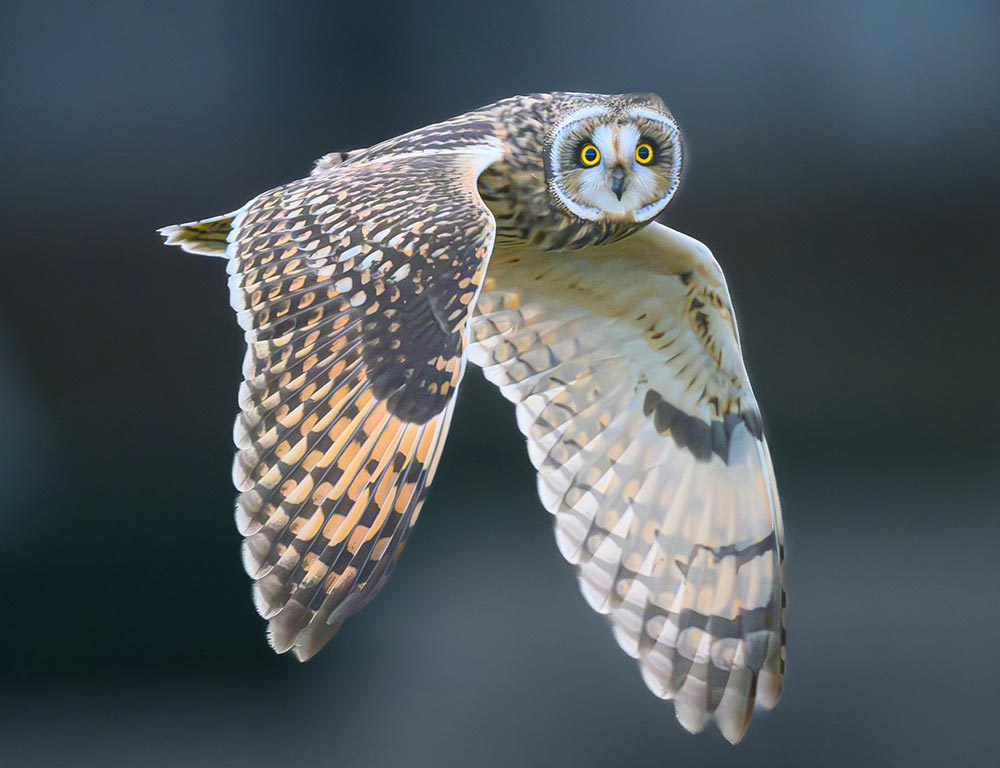
- Scientific name: Asio flammeus
- Life span: Up to 10 years
- Size: 13-17 inches
- Weight: 7-17 ounces
- Food: Small mammals, birds, insects
- Wingspan: 33-43 inches
- Status: Uncommon, migrant and winter visitor
The Short-eared Owl is a bird of open habitats and can be found in marshes, grasslands, and coastal areas of Maine.
They are known for their distinctive facial disk and habit of hunting during the day, especially at dusk and dawn. Short-eared Owls feed on small mammals, birds, and insects.
Their lifestyle is influenced by seasonal movements, and they may migrate to Maine during the winter months.
9. Boreal Owl
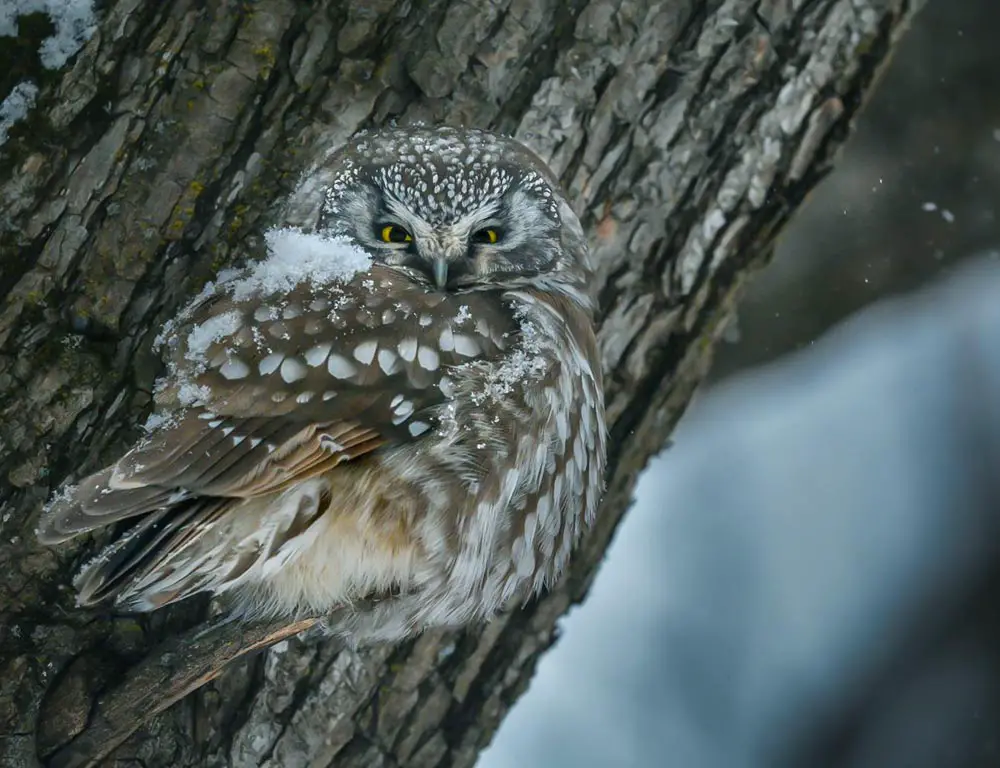
- Scientific name: Aegolius funereus
- Life span: Up to 5 years
- Size: 8-11 inches
- Weight: 3-7 ounces
- Food: Small mammals, birds, insects
- Wingspan: 21-24 inches
- Status: Uncommon
The Boreal Owl inhabits the boreal forests of Maine, favoring coniferous stands with dense canopies.
This small owl is well adapted to hunting in low light conditions, making it primarily nocturnal. Boreal Owls feed on small mammals, birds, and insects, capturing prey with precise talon strikes.
Their lifestyle involves roosting in tree cavities during the day and actively patrolling their territories at night, emitting distinctive calls to communicate with mates.
10. Burrowing Owl

- Scientific name: Athene cunicularia
- Life span: Up to 9 years
- Size: 7-10 inches
- Weight: 5-8 ounces
- Food: Insects, small mammals, reptiles
- Wingspan: 21-24 inches
- Status: Uncommon, occasional visitor
Though not a typical resident, the Burrowing Owl may be spotted in Maine during migration or occasional visits.
They prefer open grasslands and agricultural areas. As their name suggests, Burrowing Owls nest underground in abandoned burrows or dig their own.
Their lifestyle involves both day and night activity, and they are known for perching near their burrows and scanning for prey. Their diet includes insects, small mammals, and reptiles.
11. Eastern Screech Owl

- Scientific name: Megascops asio
- Life span: Up to 14 years
- Size: 6-10 inches
- Weight: 4-8 ounces
- Food: Small mammals, birds, insects
- Wingspan: 18-24 inches
- Status: Common
The Eastern Screech Owl is a common and adaptable species found in various habitats, including woodlands, parks, and suburban areas throughout Maine.
Their plumage can be red or gray, providing excellent camouflage. Eastern Screech Owls are primarily nocturnal hunters, feeding on small mammals, birds, and insects.
Their lifestyle involves roosting in tree cavities during the day, and they are known for their distinctive trilling or whinnying calls, used for communication and mate attraction.
This post invites you to unravel the mysteries of these enchanting birds, providing a glimpse into the intricate tapestry of Maine’s owl community and their significance in maintaining the delicate balance of nature.
Wrapping Up
Maine’s diverse landscapes host a captivating array of owls, each contributing to the intricate tapestry of its wildlife.
From the haunting calls of the Boreal Owl in dense boreal forests to the graceful flight of the Great Horned Owl in suburban areas, these birds play a vital role in Maine’s ecological balance.
The unique adaptations, hunting strategies, and distinctive features of each owl species contribute to the rich biodiversity that makes Maine a haven for bird enthusiasts.
Discover the silent hunters, masterful fliers, and captivating personalities of Maine’s owls.
This exploration unveils the scientific facets of these majestic birds and their role in shaping the charm of Maine’s natural habitats.
Embrace the magic of moonlit encounters and the subtle rustling of feathers as you delve into the enchanting world of Owls in Maine. Best of luck.